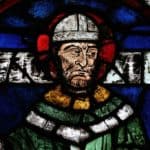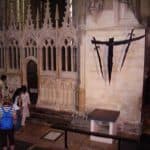Canterbury Cathedral: St. Thomas Becket, Canterbury England
About Canterbury Cathedral:
Canterbury has a Catholic history dating back to the time of Saint Augustine in the late 6th century: Saint Augustine was the first Bishop of Canterbury and began building the Cathedral there shortly thereafter.
He worked tirelessly to help spread the faith in the area; however, that is not what most people think about when they hear of Canterbury. Most of you probably know it from “Canterbury Tales” or as the site of the martyrdom of Sir Thomas Becket.
About Sir Thomas Becket (also called Saint Thomas of Canterbury):
Although Thomas Becket was originally loyal to King Henry II; after he was named Archbishop in 1162 he began to be constantly found himself in conflict with the King, who had expected him to be more amenable to his demands. As Becket went to France, the King, in 1170, had his son crowned as his heir by the Archbishop of York along with the Bishops of London and Salisbury, who obviously sided with the King.
As a result, Becket ex-communicated them. At this news the King is supposed to have made his famous comment “Who will rid me of this meddlesome priest?”

Whether the King meant this literally is open to debate, but the result was that on December 29, 1170 four knights entered the Cathedral during Vespers and confronted him. When he refused to absolve them they killed him with three blows, the last of which reportedly broke off the tip of a sword. The photo below shows a shrine to him at the place in which he was martyred.
In 1220, 50 years after his murder, the remains of Thomas Becket were carefully removed from his tomb in the cathedral’s crypt and transferred (or ‘translated’) golden casket encrusted with jewels casket in a chapel behind the high altar that had been built just for this purpose.
In just a few short days reports spread of miracles attached to his martyrdom. The windows in the Trinity Chapel portray the reported miracles.
Pope Alexander III canonized him in 1173 and we celebrate his Feast Day on December 29.
After that it became a pilgrimage destination for hundreds of thousands of pilgrims. Those who have read Geoffrey Chaucer’s “Canterbury Tales” have a glimpse of what pilgrims were like after the death of Becket.
About Canterbury Cathedral:
 The Cathedral has undergone numerous changes over the years but remains Anglican rather than Catholic, although Catholic masses have been celebrated on his feast day. It continues to draw thousands of pilgrims each year. The shrine to Saint Thomas Becket is the principal draw, of course.
The Cathedral has undergone numerous changes over the years but remains Anglican rather than Catholic, although Catholic masses have been celebrated on his feast day. It continues to draw thousands of pilgrims each year. The shrine to Saint Thomas Becket is the principal draw, of course.
In 1986, a new Martyrdom Altar (shown here) was installed on the spot where Thomas Becket was slain. Mounted on the wall above the altar is a metal sculpture depicting a cross flanked by two bloodstained swords which, together with the shadows they cast, represent the four knights who killed Becket. There is also a plaque commemorating the visit of Pope John Paul II in 1982.
Although the tomb of Thomas Becket may be the main attraction here, there a quite a few other Saints entombed here as well.
Traveling to Canterbury Cathedral:
It is an easy drive by car or taxi from London and also serviced by rail. Several bus lines also serve the city from hotels in London.
Address: 11 The Precincts Canterbury, Kent CT1 2EH
GPS coordinates: 51° 16′ 47.2692” N, 1° 4′ 58.0800” E
Tel: +44 (0) 1227 762862 Fax: +44 (0) 1227 865222 |
e-mail: enquiries@canterbury-cathedral.org
Click here for the official website of the Canterbury Cathedral. Be sure to click on through to the “visitor’s guide” for great detailed information about its’ history.
⇐ Back to Catholic shrines & places of interest in the United Kingdom

